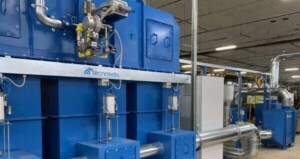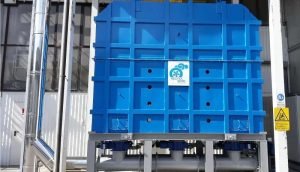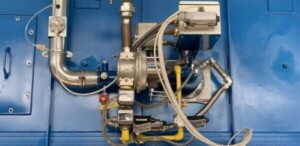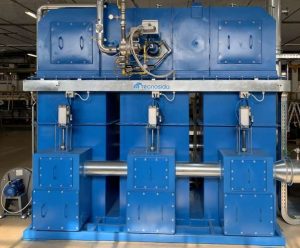Regenerative Thermal Oxidizers (RTOs)
Thermal Oxidizers for combustion of organic substances
What are Regenerative Thermal Oxidizers (RTOs)?
Post-combustion is effectively used for thermal oxidation of airflows containing volatile organic pollutants (VOCs).
This process takes place in a combustion chamber, where the pollutants inside the effluent to be treated are burned. This process generally decomposes the pollutants into carbon dioxide (CO2) and water vapour (H2O), with a very high efficiency (>99.9%).
The extreme flexibility of the system allows to treat different types of VOCs, even complex ones. These include organohalogens and organosilicates, which are treated by using specific non-standard solutions.
Post-combustion: types and operating principles
The thermal process of high temperature oxidation transforms harmful components into harmless substances: carbon dioxide (CO2) and water vapour (H2O). Several machines can carry out thermal oxidation. The choice is based on different aspects, such as the pollutant concentration and the thermal efficiency level to be obtained. Below are the existing oxidizers:
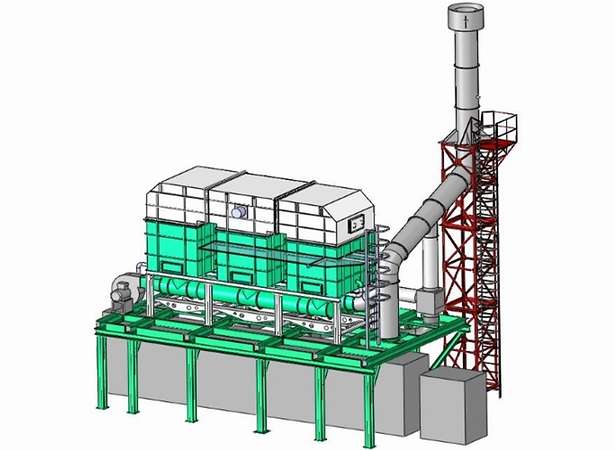
Direct fired Thermal Oxidizer:
It is a thermal oxidiser without heat recovery. It is composed of a conveniently designed combustion chamber with a burner which thermally oxidates pollutants. At the end of the chamber, it is possible to insert different types of recovery based on the customer’s needs (usually recovery on diathermic oil, water to produce steam or other types of recovery).
Recuperative Thermal Oxidizer:
It is an oxidiser with heat recovery on the incoming dirty exhaust. The effluent recovers heat from the burned gases to reduce the auxiliary fuel consumption. It is also possible to further use the residual heat in fumes by installing a second heat recovery system on air or water as needed.
Regenerative Thermal Oxidizers (RTOs):
It is a combustor with a regenerative heat exchanger. It is made of ceramic material conveniently dimensioned to reach a heat recovery efficiency higher than 95%. Depending on the concentration of oxidized pollutants, it can also potentially lead to the system self-sufficiency, eliminating the auxiliary fuel consumption. Also in this case it can be possible to install a final heat recovery system on the chimney for air or water, depending on the system operating conditions.
Catalytic Thermal Oxidizer:
It is a combustor which uses a catalyst for oxidation at lower temperatures (around 300-400°C) with the same or better environmental efficiency. It is possible to install a heat exchanger on the system to increase heat recovery and to further reduce the auxiliary fuel consumption.
Thermal oxidizers vs halogenated and sulphur VOCs
The processes involving halogenated and sulphur VOCs can create acid, which must be treated with our scrubber for wet abatement of the effluent after the thermal oxidation. Among this type of compounds, the treatment of Sulphuric acid is particularly complex. Around 230-250°C (dewpoint), it starts to condense, seriously endangering the system and putting it at risk of corrosion. To mitigate this condition, specific coatings or materials of special composition are used, in addition to the installation of specific quenching and abatement systems.
Regenerative Thermal Oxidizers (RTOs): advantages
The Regenerative Thermal Oxidizer:
- ensures the highest possible abatement efficiency, even exceeding that required by the international standards;
- is composed of modular units, allowing very rapid pre-assembly and minimising the installation time at the construction site and the customer’s machine downtime.
Regenerative Thermal Oxidizers (RTOs): technology application
Over the years, we have manufactured Regenerative Thermal Oxidizers (RTOs) for thermal oxidation of Volatile Organic Compounds (VOCs) in different contexts, including:
- coating of components for the automotive sector;
- manufacture of plastic preforms, abrasive sector;
- flexible packaging production.
Thermal Oxidizer: additional options
A heat exchanger allowing to further recover the sensible heat of the outgoing fumes can be designed. This sensible heat can be used to heat up air, diathermic oil or water or to produce vapour.
Thermal oxidizer: maintenance
Tecnosida® also plans regular ordinary and extraordinary maintenance to verify the structure of the system. This service is also available for the Regenerative Thermal Oxidizer and it ensures:
- proper functioning of the oxidizer;
- high combustion efficiency;
- waste reduction (both in economic and energy terms).
For further information, do not hesitate to contact us: we will plan this important activity with you!
Thermal oxidizer: remote management systems
The Regenerative Thermal Oxidizer can be equipped with remote management systems for performance and operation monitoring. Contact Tecnosida® for specific advice tailored to the technical situation of your company!
